
Original Link: https://www.anandtech.com/show/2518
Introduction
Most people like to get as much information as possible when it's time to purchase and new, relatively expensive item. Unless you have money to throw around, you typically don't want to overpay for something that underperforms. That's where roundups of a product category can be particularly useful; unfortunately, it's not always easy to get all of the products in one place in order to put together such a roundup. What started as a review of a couple new 24" LCDs eventually grew into what you see here: a comparison of five of the most recent 24" LCDs to hit the market... that we were able to acquire. Note the qualification at the end of that sentence; there are still plenty of 24" LCDs that we have not yet reviewed, but for now we'll take what we can get. Besides, trying to put together all of the information for this article took enough time as it is.
We've discussed LCD panel technologies in the past, and we've often had negative comments for TN panels in particular. The biggest problem with TN panels is that they have far more limited viewing angles, often to the point where a minor adjustment in where you're sitting can affect what you see on the display. However, it just may be that there are benefits to TN panels as well. Look at most specifications and you will find lower response times advertised for TN panels than for competing PVA and IPS panels. Perhaps the biggest advantage for TN panels, however, is price. As the original LCD technology, TN panels have had a long time to mature and manufacturers are far more comfortable with them. Thus, it's little surprise that the prices are usually lower than what we find on S-PVA panels.
It used to be that all 24" LCDs used S-PVA panels, but that has begun to change during the past year. Cost has certainly been an important factor, but regardless we're beginning to see more and more 24" TN-based LCDs. Of the five new LCDs we're reviewing today, three use TN panels while two continue to use S-PVA panels. The latter do indeed cost more, but they also target a different market. Where the TN-based LCDs are intended for the consumer market, the S-PVA LCDs generally target the professional market.
We have a ton of information to cover in this article, so let's get to it. We're going to let the images do the talking for a lot of the areas we normally dwell on, and focus primarily on any noteworthy items that may not be immediately apparent. Also, feel free to consult our short glossary of terms that we use in our display reviews before continuing.
ASUS MK241H Specifications and Appearance
| ASUS MK241H Specifications | |
| Video Inputs | DVI with HDCP support HDMI Analog (VGA) |
| Panel Type | TN (ACI 24A1) |
| Pixel Pitch | 0.270mm |
| Colors | 16.7 million (6-bit with dithering/interpolation?) 130% color gamut |
| Brightness | 450 cd/m2 |
| Contrast Ratio | Up to 3000:1 (Dynamic) |
| Response Time | 2ms GTG |
| Viewable Size | 24" diagonal |
| Resolution | 1920x1200 |
| Viewing Angle | 170 horizontal/160 vertical |
| Power Consumption | <130W max stated 74W max, 29W min measured |
| Power Savings | <2W |
| Screen Treatment | Matte (non-glossy) |
| Height-Adjustable | No |
| Tilt | Yes - 30 degrees back/5 degrees forward |
| Pivot | No |
| Swivel | No |
| VESA Wall Mounting | 100mm x 100mm |
| Dimensions w/ Base (WxHxD) | 23" x 18" x 9.6" (WxHxD) |
| Weight w/ Stand | 19 lbs. |
| Additional Features | Integrated 1.3MP webcam and mic (USB connection to PC required) |
| Audio | 2 x 2W Speakers Audio in, Line out |
| Limited Warranty | 1-year parts and 3-year labor |
| Price | Online starting at ~$530 |
ASUS claims an impressive 130% color gamut for the MK241H. That seems rather high, and some of you may be wondering how exactly a display can be higher than 100%. The reason is quite simple: color gamut is usually measured against the NTSC standard, which is getting a little long in the tooth. Modern technology is thus able to exceed that standard, though it requires the use of an appropriate color space in order to do so. Naturally, we'll see whether there's any truth in the 130% claim.
Most of the remaining features are typical of an entry-level 24" monitor. The MK241H includes DVI, HDMI, and VGA inputs and it has built-in speakers (that as you might expect don't sound particularly good, but they'll get the job done if all you need is basic audio). In other areas, the ASUS LCD is more spartan. It lacks height, tilt, and pivot functionality; none of these are absolutely necessary, but we appreciate them nonetheless. The MK241H also lacks any USB ports, but it makes up for this by including an integrated webcam and microphone. That last is one of the few things that sets this LCD apart from other offerings.
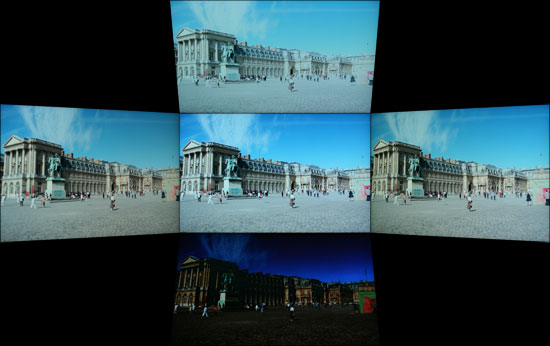 |
The MK241H uses a TN panel, and the biggest drawback to such a panel is the limited viewing angles. TN panels have improved over the years, to the point where many people are no longer bothered by the viewing angle limitation. Still, they are clearly inferior in this area to PVA and IPS panels. Looking at TN panels from below is the worst-case scenario, and in fact they are practically unusable from this angle. However, this should not be a problem for most users unless you tend to work on your computer while lying down.
The MK241H is a reasonably nice looking LCD whose appearance is marred by the presence of many stickers proclaiming the various features it comes with. It's possible to remove most of the stickers with a bit of effort, but we would prefer not to have to look at marketing material every day we use an LCD. Most of the information would make more sense on the packaging material -- though of course it's already there as well. While the LCD does not come with a full-featured base stand, it's not quite as flimsy as some of the cheapest LCDs we've seen on the market are. It is a little odd that ASUS includes a "warranty void if seal damaged" sticker on the stand, however, as anyone wanting to use a VESA wall mount will definitely want to take the stand off.
ASUS MK241H Evaluation
One aspect of any display that can be relatively important is the on-screen display (OSD), which controls functions such as brightness, contrast, aspect ratio, color correction, and other options. The MK241H includes five preset "modes" that tweak the various settings. We generally prefer sticking with the unbiased "standard" preset, as most of the other modes are too bright, too warm, too cool, etc. Still, tastes will vary, so if you're not doing professional image editing you may find that one of the other presets is to your liking. ASUS includes functions in the OSD for all the major areas, though their menu system is not as extensive as for example the Samsung 245T. Then again, sometimes less is more -- we rarely tweak most of the settings that are available and ASUS provides us with everything we need.
You can see the various options available in the menu system in the above gallery. We do have to mention that the OSD buttons are super "clicky" (i.e. they're loud and require more pressure to activate). This is almost the opposite end of the spectrum from the Samsung 2493HM, but we'll take the ASUS style over the "floaty" buttons on the Samsung. Noteworthy items include the "trace free" function that is supposed to improve pixel response time and the options for aspect ratio control. In the case of the former, response time didn't seem to be any better or worse than other LCDs that we've used -- but then we haven't had a problem with gaming on LCDs for the last three years; your mileage may vary.
For aspect ratio control, ASUS provides three options: Full, 4:3, and 1:1. "Full" theoretically stretches whatever resolution you're running to fill the whole screen. "4:3" is for standard aspect ratio resolutions and will leave you with black bars on the left and right sides (even if you happen to be running a widescreen resolution). "1:1" is a direct-mapped mode without any stretching, leaving black bars on all sides (depending on what resolution you're running). Notice how we said "theoretically"? Not all of the normal resolutions work properly with the aspect ratio control, depending on what input you're using. Here's a summary of our resolution testing:
| ASUS MK241H Resolution and Input Notes | |||
| DVI | HDMI | VGA | |
| 800x600 | Yes | Yes | Yes |
| 1024x768 | Yes | Yes | Yes |
| 1152x864 | Yes | Yes | - |
| 1176x664 | - | Underscanned 720P | - |
| 1280x720 | Yes | Yes | Yes |
| 1280x768 | - | Wrong AR (1280x960) | Sets 1280x800 and clips top and bottom |
| 1280x800 | Wrong AR (1280x960) | Wrong AR (1280x960) | Yes |
| 1280x960 | Yes | Yes | Yes |
| 1280x1024 | Yes | Yes | Yes |
| 1400x1050 | - | Wrong AR (1680x1050) | - |
| 1440x900 | Yes | Yes | Yes |
| 1600x1200 | Yes | Yes | Yes |
| 1680x1050 | Yes | Yes | Yes |
| 1768x992 | - | Underscanned 1080P | - |
| 1920x1080 | Interference/Static Present | Yes | Clips output to 1680x1050 |
| 1920x1200 | Yes | Yes | Yes |
The built-in scaler works well on VGA, but the scaling artifacts on digital inputs are horrific. If you have an NVIDIA GPU, you should use the NVIDIA Scaling to avoid this. 1:1 scaling also works for most resolutions/inputs if you don't mind black borders. Otherwise, you'll want to stick to the native resolution when using DVI or HDMI inputs. There were also several resolutions that would not display with the correct aspect ratio (AR) when using HDMI and one resolution had problems with the DVI connection. Out of the five LCDs tested here, the OSD and firmware appears to need the most work on this LCD. Only the VGA input generally works properly and scales well on most resolutions.
Ideally, you always want to run at the native LCD resolution, but sometimes that's not possible -- i.e. for performance reasons you may want to run a game at a lower resolution. Again, if you're using a digital connection -- and we generally recommend the use of a digital connection with LCDs -- the MK241H has severe scaling artifacts when you stretch lower resolutions to fill the screen. You can see what we mean with the following shot of the LCD running at 1440x900.
 |
We're not quite sure why, but the built-in scaler seems to be doing a "nearest neighbor" interpolation on digital signals. This does not occur on VGA connections, where you get a more appropriate bilinear or bipolar scaling. The drawback is that overall VGA connections do not have the clarity of digital connections, and if you switch resolutions frequently, you will have to deal with the "auto calibration" delay at times.
We'll compare Delta E and color gamut scores to all of the other LCDs later in this article, but we wanted to give a quick preview of the color accuracy to make things more manageable. The following chart shows the calibrated and uncalibrated color accuracy using Monaco Optix XR Pro and ColorEyes Display Pro with a DTP94 colorimeter. Below that is a 3D color gamut volume compared to the Adobe RGB 1998 standard, which was generated using Gamutvision, a utility developed by Imatest LLC.
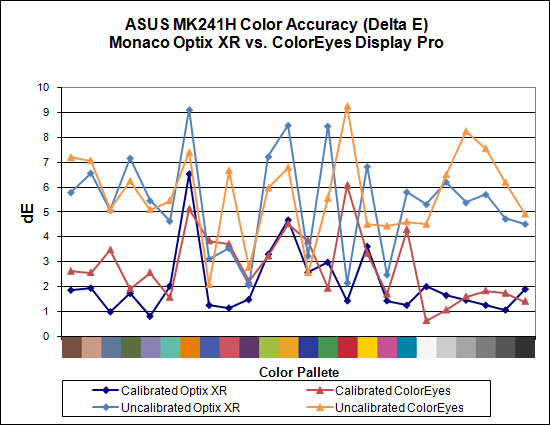
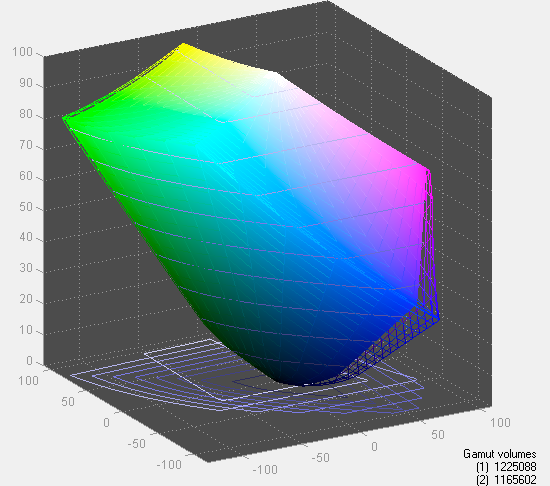
Overall color accuracy is reasonably good, with a few colors that always seem to end up with a much higher Delta E. The average after calibration scores right around 2.0 (~5.5 prior to calibration), and the vast majority of users will have no problems with the MK241H -- or pretty much any other LCD for that matter. Imaging professionals on the other hand may want to look elsewhere. We can also see that in regards to color gamut, the ASUS panel scores very well but it doesn't come anywhere near 130% when compared to the Adobe RGB 1998 standard. So they lied, right? Well, not really... the color gamut also happens to be 140% of the sRGB standard most computers use. The Adobe RGB 1998 standard is for imaging professionals, and applications like Adobe Photoshop make use of it in order to offer better color reproduction.
The bottom line is that the ASUS MK241H is a decent display at a reasonable price. It doesn't top the charts in most areas, and the lack of pivot and height adjustment functionality may be a concern for some users. The scaling problems with digital inputs and lower resolutions is also a pretty serious problem, so without some firmware update to address this we can only recommend the MK241H for people that intend to run only at the native resolution. If you can get past those qualifications and you want an LCD with an integrated webcam, you can find the MK241H online for around $530. There are less expensive 24" LCDs, but if we sound somewhat critical of ASUS trust us: the least expensive 24" LCDs tend to have even more problems. (That's probably why none of the manufacturers want to send them out for review.)
Dell 2408WFP Specifications and Appearance
| Dell 2408WFP Specifications | |
| Video Inputs | 2 x DVI with HDCP
support HDMI DisplayPort Analog (VGA) Component S-Video Composite |
| Panel Type | S-PVA (DELA02A) |
| Pixel Pitch | 0.270mm |
| Colors | 16.7 million (8-bit) 110% color gamut |
| Brightness | 400 cd/m2 |
| Contrast Ratio | Up to 3000:1 Dynamic |
| Response Time | 6ms GTG |
| Viewable Size | 24" diagonal |
| Resolution | 1920x1200 |
| Viewing Angle | 178 vertical/horizontal |
| Power Consumption | <130W max stated 90W max, 45W min measured |
| Power Savings | <2W |
| Screen Treatment | Matte anti-glare (non-glossy) |
| Height-Adjustable | Yes - 3.9 inches |
| Tilt | Yes - 21 degrees back/3 degrees forward |
| Pivot | Yes |
| Swivel | Yes - 45 degrees left/right |
| VESA Wall Mounting | 100mm x 100mm |
| Dimensions w/ Base (WxHxD) | 22.04" x 15.62" x 8.17" lowered
(WxHxD) 22.04" x 19.56" x 8.17" raised (WxHxD) |
| Weight w/ Stand | 21.74 lbs. |
| Additional Features | (2) USB 2.0 - left, (2) USB 2.0 -
back 9-in-2 Flash reader (USB connection to PC required) |
| Audio | Audio out Optional speaker bar |
| Limited Warranty | 3-year parts and labor (when purchased from
Dell) 4-year ($39) and 5-year ($59) optional upgrades from Dell |
| Price | MSRP $699 Online starting at ~$580 |
The Dell 2408WFP follows in the footsteps of Dell's successful 24" LCD line. The 2405FPW was one of the first 24" LCDs to hit the market, and early adopters loved it. The 2407WFP changed the appearance slightly and added a few extra features like HDCP support, while the 2407WFP-HC offered an improved color gamut. The 2408WFP looks nearly identical to the 2407WFP, but it improves the color gamut again -- this time to 110% -- and it also adds additional input options. It has two DVI inputs, and HDMI input, and it's one of the few current LCDs to support DisplayPort. (As we did not have an appropriate graphics card, we were not able to test the DisplayPort input.)
Besides the improved color gamut and the additional inputs, very little has changed relative to the 2407WFP. That's not a bad thing however, is that remains one of the better LCDs on the market. In the features department, you get a fully functional base stand with pivot, swivel, and height adjustment. You also get a 9-in-2 flash reader and four USB ports. Our only complaint with the stand is that even at maximum height it can be a bit difficult to pivot the LCD into portrait mode; you'll need to tilt the LCD all the way back before you can properly pivot the panel. As far as complaints go, that's a truly minor nitpick.
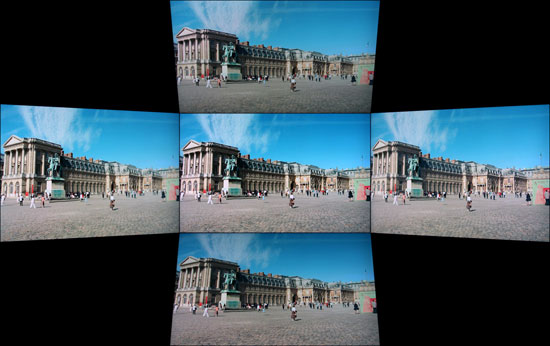 |
Like the previous Dell 24" LCDs, the 2408WFP uses an S-PVA panel. That means you get all of the good features like better viewing angles and reasonable response times. However, as we'll see later, the S-PVA panels also seem to suffer from input lag -- more so than any other panel type. Whether that's something inherent in the technology were simply a delay caused by the video processing engine, we can't say for sure, and we were never really bothered by the input lag. More demanding gamers however might be put off, as there appears to be a 2-3 frame lag.
In our subjective opinion, Dell's LCDs continue to be some of the most attractive offerings on the market. Some people like glossy panels or bezels; we prefer a matte finish that won't immediately pick up fingerprints. Again, outside of the changes to the connections on the back of the LCD, the 2408WFP looks identical to the 2407WFP.
Dell 2408WFP Evaluation
Looking at the OSD, the 2408WFP again follows in the footsteps of the 2407WFP. It comes with seven color presets, which can be further modified by selecting "graphics" or "video". PC and Mac gamma settings are also available. Picture-in-picture (PIP) is also available, provided one of the inputs is an analog connection.
You can see the various options available in the menu system in the above gallery. In terms of OSD buttons, we prefer Dell's approach to any of the other LCDs we've tested. Some people like "cloaked" touch-sensitive buttons, but we feel they tend to be less precise. Noteworthy items include DDC/CI support that can be used with calibration software and the options for aspect ratio control. This happens to be the first LCD we've tested that we were able to calibrate using DDC mode in ColorEyes Display Pro -- not that the results were significantly better, but it was nice to be able to input target values and have the software do the "dirty work" for us. About the only option that's missing is the ability to move the OSD away from center. (It can interfere with color calibration if you activate it with a colorimeter at the center of the LCD.)
For aspect ratio control, Dell provides three options: 1:1, Aspect, and Fill. Similar to the ASUS MK241H, "Fill" stretches whatever resolution you're running to fill the whole screen and "1:1" is a direct-mapped mode without any stretching, leaving black bars on all sides (depending on what resolution you're running). "Aspect" is a proportional stretch mode that maintains the resolution aspect ratio, so for example 1024x768 ends up filling 1600x1200 pixels (as do all other 4:3 aspect ratio resolutions) and 1280x1024 ends up filling 1500x1200. Here's a summary of our resolution testing:
| Dell 2408WFP Resolution and Input Notes | ||||
| Component | DVI | HDMI | VGA | |
| 800x600 | Yes | Yes | Yes | |
| 1024x768 | Yes | Yes | Yes | |
| 1152x864 | Yes | Yes | Yes | |
| 1176x664 | Underscanned 720P | - | Underscanned 720P | - |
| 1280x720 | Overscans (no way to disable) | Yes | Yes | Yes |
| 1280x768 | - | Wrong AR (1280x1024); Use "Full" scaling | Yes | |
| 1280x800 | Wrong AR (1280x1024); Use "Full" scaling | Wrong AR (1280x1024); Use "Full" scaling | Yes | |
| 1280x960 | - | Wrong AR (1280x1024) | Yes | |
| 1280x1024 | Yes | Yes | Yes | |
| 1400x1050 | - | Wrong AR (1920x1080) | - | |
| 1440x900 | Wrong AR (1600x1200); Use "Full" scaling | Wrong AR (1920x1080); Use "Full" scaling | Yes | |
| 1600x1200 | Yes | Yes | Yes | |
| 1680x1050 | Always fills LCD ("Full") | Wrong AR (1920x1080); Use "Full" scaling | Yes | |
| 1768x992 | Underscanned 1080i | - | Underscanned 1080P | - |
| 1920x1080 | Overscans (no way to disable) | Yes | Yes | Yes |
| 1920x1200 | - | Yes | Yes | Yes |
Most of the tested resolutions more or less work properly on any of the three main computer inputs. VGA mode performs flawlessly, while on DVI and HDMI inputs some of the widescreen resolutions require you to manually select "Fill". If you want a 1:1 image, a few resolutions have problems on DVI and most of the lower widescreen resolutions fail to work in this mode. As with all LCDs, there's an "auto adjust" function that executes when you change resolutions while using an analog input (i.e. VGA). This function works as expected and takes a couple seconds to execute; it apparently remembers the last 10 resolutions you've used; otherwise, the auto adjustment runs again.
Component input is rather disappointing, as 720P and 1080I both have ~10% overscan; using a PC, you can output 1176x664 or 1768x992 to avoid this, but if you're using a computer you will probably want to use one of the other input options. Even then you still end up with a black bar on the right. The 30Hz HDMI modes all overscan as well (1280x720, 1400x1040, 1440x900, 1680x1050, and 1920x1080) and show scaling/de-interlacing artifacts; in other words, don't use them if you can avoid it. Overall, 1080I seems better than 720P on the component video connection, so if you plan to connect the LCD up to a component video source, we would run 1080I.
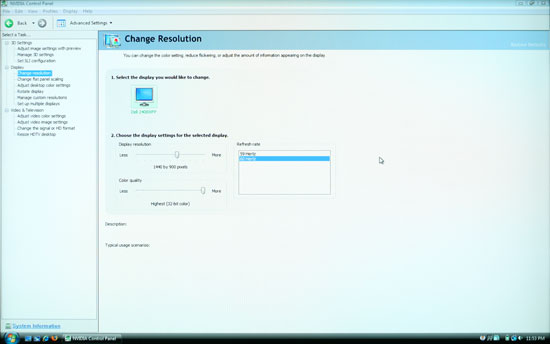 |
As you can see in the above image, scaling artifacts from over resolutions are not a serious problem. Running at the native resolution is definitely preferred, but if you happen to run a game at a lower resolution you should be fine. Connecting a gaming console to any of the inputs should also work well, but keep in mind the aspect ratio comments from above.

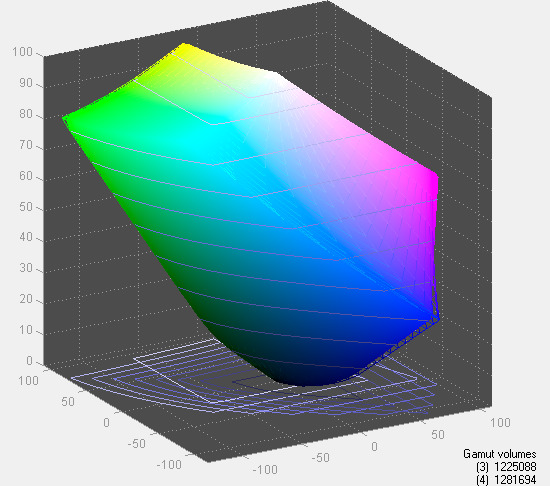
Taking a quick look at color accuracy and gamut, the overall color accuracy is exceptional. If you look at the above results, you might not believe that we were able to achieve a Delta E of only 1.7 without calibration! Yes, that's right: without hardware calibration, the Dell 2408WFP can surpass many other LCDs with hardware calibration. Just to be clear, we set the brightness and contrast to 50, selected the custom color profile, and dropped the RGB settings to 80; otherwise, the default settings tend to be quite bright. After calibration, scores further improve to an extremely low 0.78 average. The highest Delta E after calibration is only 1.31. Color gamut is also exceptional, and this is the only display we've tested so far that achieves better than 100% of the Adobe RGB 1998 standard.
Simply put the colors and color accuracy of the Dell 2408WFP absolutely blew us away. If you're an imaging professional and you're using Windows (we have heard there can be some issues with high gamut LCDs under Mac OS X, particularly with the Safari web browser), this is the best LCD we've tested so far. Perhaps more surprising is the fact that you can pick it up for only $600 (at least with the current sale -- MSRP is usually $700). Top that off with a 3-year manufacturer warranty and you've got a delicious LCD soup ready to serve up. The only fly in the ointment is the aforementioned input lag, which could present problems if your primary computer applications or games and your reflexes are so honed that you can notice the ~30ms lag. If that's the case, you'll probably need to compromise on image quality and pick up a TN panel LCD.
Gateway FHD2400 Specifications and Appearance
| Gateway FHD2400 Specifications | |
| Video Inputs | DVI with HDCP support HDMI Analog (VGA) Component S-Video Composite |
| Panel Type | TN (GWY 0968) |
| Pixel Pitch | 0.270mm |
| Colors | 16.7 million (6-bit with
dithering/interpolation?) 92% color gamut |
| Brightness | 400 cd/m2 |
| Contrast Ratio | 1000:1 Static |
| Response Time | 3ms GTG with UltraResponse 5ms GTG without UltraResponse |
| Viewable Size | 24" diagonal |
| Resolution | 1920x1200 |
| Viewing Angle | 160 horizontal/vertical |
| Power Consumption | <150W max stated 76W max, 36W min measured |
| Power Savings | <2W |
| Screen Treatment | Glossy UltraBright |
| Height-Adjustable | Yes - 5.00 inches |
| Tilt | Yes - 25 degrees back/5 degrees forward |
| Pivot | Yes |
| Swivel | Yes - 360 degrees (with sufficient space) |
| VESA Wall Mounting | 100mm x 100mm |
| Dimensions w/ Base (WxHxD) | 22.48" x 17.36" x 9.92" lowered
(WxHxD) 22.48" x 22.36" x 9.92" raised (WxHxD) |
| Weight w/ Stand | 17.2 lbs. |
| Additional Features | (2) USB 2.0 - left, (2) USB 2.0 -
back (USB connection to PC required) Faroudja video processing |
| Audio | Optional speaker bar |
| Limited Warranty | 1-year parts and labor 3-year optional upgrades from Gateway ($30) |
| Price | MSRP $500 Online starting at ~$450 |
The Gateway FHD2400 is similar to the Dell 2408WFP in some ways: you get a bevy of input options and a fully functional stand. Move beyond that areas and there are plenty of differences. First, like the ASUS MK241H the FHD2400 uses a TN panel. Unlike all of the other LCDs in this roundup, the Gateway includes a glossy panel. You can easily see reflections in the LCD, particularly when it's off or showing dark content in a well-lit room, but in normal use it's not much of a problem. In fact, we can stop right now for those of you that like glossy displays: this is a great 24" LCD and definitely gets our recommendation for the glossy club. (However, there are a few other caveats that we will get to shortly.)
Gateway doesn't offer quite as many input options as Dell, but then we imagine the vast majority of users will only use one input anyway. Still, you get HDMI and DVI digital inputs, VGA for analog computer use, and component video in case you want to use the display as an HDTV. (Does anyone actually still use S-Video or composite inputs?)
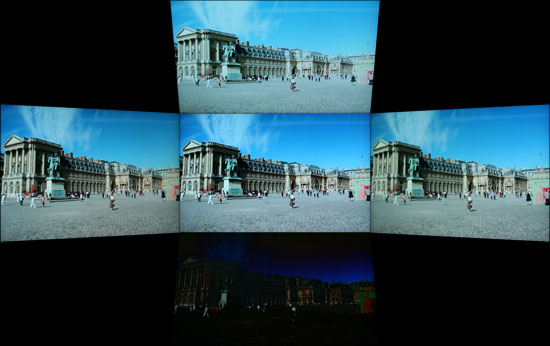 |
In some ways, the Gateway stand is the best of the bunch today. It has two small wheels on the bottom that allow you to rotate the display 360° -- and beyond as long as you manage to keep the cables out of the way. You need quite a large surface area to do this, but then most people will be okay swiveling the display 20 or 30° to the left or right. The aspect that we truly appreciate with the Gateway stand is that it offers 5" of height adjustment. Why is that important? It allows you to easily pivot the display into portrait mode, and you won't find us complaining about an extra inch in height adjustment. Even if you don't use the portrait mode, the pivot function proves to be extremely convenient when connecting or disconnecting cables -- we definitely missed it on the two LCDs that don't pivot. Similar to the Dell display, the stand also has a cutout in the center that can be used for cable management.
Based purely on appearance, we would rate the Gateway FHD2400 has the best-looking LCD of the bunch. That's a completely subjective opinion, of course, but a silver stand and accents with the glossy LCD panel are definitely eye-catching. Like ASUS, Gateway does put something of a blemish on the exterior by including a large marketing sticker in the bottom-right corner listing the various features, but take that off and you're left with an elegant LCD.
Gateway FHD2400 Evaluation
The Gateway OSD remains largely unchanged since last Gateway LCD we reviewed -- the Gateway FPD2485W. It worked well over a year ago and it continues to work well today. Gateway uses a touch-sensitive buttons system on the right side of the LCD, but rather than leaving you to guess where to press, all of the active buttons light up as soon as you press the menu button. Our only complaint is that there are areas where Gateway could make better use of the buttons.
As an example, when you first activate the menu there are six buttons plus an additional two buttons up top that cycle through the color presets. These six buttons allow you to jump directly to one of several areas. Once you enter the Main menu, however, you then have to use the top two buttons to move up and down with the third button functioning as a select key. Granted, there are eight options in the main menu, but two of these (Auto and Reset) could easily be moved to a submenu. As a whole, though, this is a minor complaint on an OSD setup that works well.
Gateway includes seven color presets, one of which is "User" and allows manual adjustment of the color levels. Gateway also includes support for RGB and YUV color spaces. Also of interest is the "UltraResponse" function that supposedly improves pixel response times -- not that we could really tell. Gateway claims 3ms with UltraResponse enabled versus 5ms without UltraResponse.
The FHD2400 has four aspect ratio options: Wide, Zoom, 1:1, and Panoramic. "Panoramic" scaling only shows up with component (and perhaps other analog video connections), but then it just seems to do the same thing as "Wide". "Wide" fills the entire LCD with your current resolution, while "Zoom" fills the height or width while maintaining the correct aspect ratio. "1:1" is again a direct-mapped mode without any stretching. Here's a summary of our resolution testing:
| Gateway FHD2400 Resolution and Input Notes | ||||
| Component | DVI | HDMI | VGA | |
| 800x600 | Yes | Yes | Yes | |
| 1024x768 | Yes | Yes | Yes | |
| 1152x864 | Yes | Yes | Yes | |
| 1176x664 | Underscanned 720P | - | Underscanned 720P | - |
| 1280x720 | Yes | Yes | Yes | Yes |
| 1280x768 | Yes | Wrong AR (1280x1024) Use "Zoom" scaling |
Yes | |
| 1280x800 | - | Wrong AR (1280x1024) Use "Zoom" scaling |
- | |
| 1280x960 | Yes | Yes | Yes | |
| 1280x1024 | Yes | Yes | Yes | |
| 1400x1050 | - | Yes | - | |
| 1440x900 | Yes | Yes | Yes | |
| 1600x1200 | Yes | Wrong AR Always fills LCD ("Zoom") |
Yes | |
| 1680x1050 | Yes | Yes | Yes | |
| 1768x992 | Underscanned 1080i | - | Underscanned 1080P | - |
| 1920x1080 | Too much flicker | Yes | Yes | Yes |
| 1920x1200 | - | Yes | Yes | Yes |
First, let's get this out of the way: the component connection is only really suitable for 720P or 1080i signals. In general, the 720P option looks much better -- the opposite of the 2408WFP when using a component connection. All resolutions with more than 720 scanlines show severe flicker on component, as they run 60Hz interlaced. The other tested input options all work much better. VGA and DVI achieve a perfect score on all of the available resolutions, with no scaling abnormalities. Also worth mentioning is that the "Auto adjust" function on VGA is very fast. HDMI input has a few errors that you can work around by manually selecting "Wide" scaling; only 1600x1200 as an uncorrectable error in that it always fills the entire LCD, regardless of what scaling mode you choose.
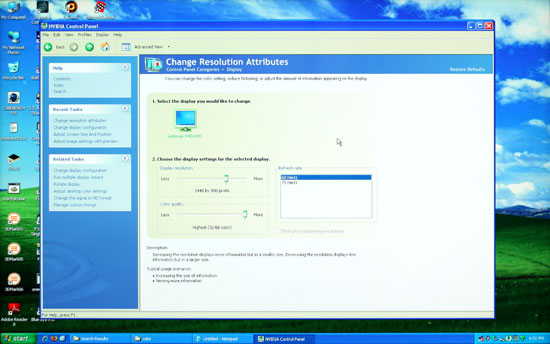 |
Running at non-native resolution, the FHD2400 does well at scaling the image to fit the panel and there are no serious artifacts. Obviously, 1920x1200 is still the optimal setting, but if you need to play a game or watch a movie at a lower resolution, you shouldn't have any complaints.
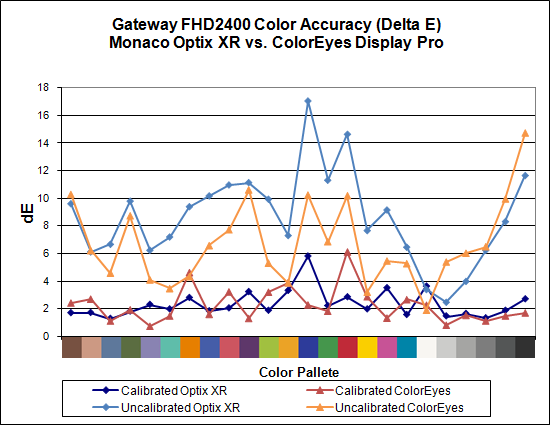
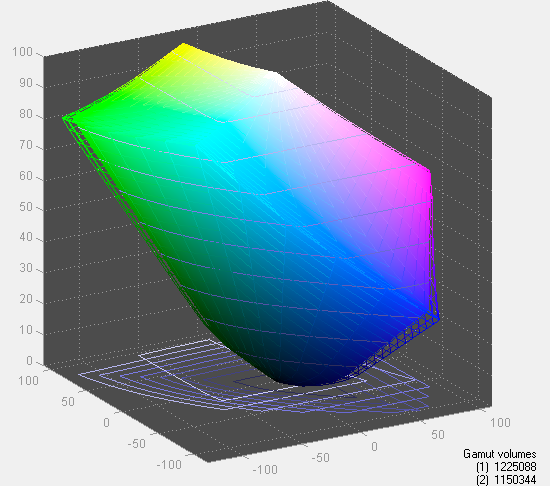
Besides limited viewing angles -- which are a problem on all TN panels today -- the one sticking point with the Gateway FHD2400 is color accuracy. After calibration, it achieves an average Delta E of only 2.3, which puts it in last place among tested LCDs. Uncalibrated color accuracy is also quite poor, coming in at 8.6 with plenty of colors above 10.0. Imaging professionals will almost certainly want something better. The good news is that the color gamut is good, achieving over 95% of the Adobe RGB 1998 standard.
The Gateway FHD2400 is sort of the opposite of the Dell 2408WFP. The Dell offers the absolute worst input lag but has by far and away the best color accuracy. The FHD2400 doesn't suffer from input lag at all, but unfortunately it has some of the worst color accuracy among tested LCDs. It's still a beautiful looking LCD, and it gets so many things right that we have no qualms recommending it to non-imaging professionals. That goes double if you'd like glossy LCD panels.
LaCie 324 Specifications and Appearance
| LaCie 324 Specifications | |
| Video Inputs | DVI with HDCP support 2 x HDMI Analog (VGA) |
| Panel Type | S-PVA (LCA 24B2) |
| Pixel Pitch | 0.270mm |
| Colors | 16.7 million (8-bit) 92% color gamut |
| Brightness | 400 cd/m2 |
| Contrast Ratio | 1000:1 Static |
| Response Time | 6ms GTG |
| Viewable Size | 24" diagonal |
| Resolution | 1920x1200 |
| Viewing Angle | 178 vertical/horizontal |
| Power Consumption | <140W max stated 88W max, 43W min measured |
| Power Savings | <2W |
| Screen Treatment | Matte (non-glossy) |
| Height-Adjustable | Yes - 2.75 inches |
| Tilt | Yes - 25 degrees back/3 degrees forward |
| Pivot | No |
| Swivel | Yes - 170 degrees left/right |
| VESA Wall Mounting | 100mm x 100mm |
| Dimensions w/ Base (WxHxD) | 22.28" x 16.45" x 8.97" lowered
(WxHxD) 22.28" x 19.21" x 8.97" raised (WxHxD) |
| Weight w/ Stand | 23.81 lbs. |
| Additional Features | (3) USB 2.0 - left (USB connection to PC required) 10-bit gamma correction DCDi Faroudja video processing |
| Audio | Audio in, Line out |
| Limited Warranty | 3 year parts and labor with advance replacement |
| Price | MSRP $1060 Online starting at ~$900 |
LaCie is a company known for catering to the professional imaging market. They also happen to offer a product called LaCie blue eye pro, which consists of both a colorimeter and calibration software. We were quite interested to see how the LaCie 324 stacks up to the competition, as we thought maybe we would finally see an LCD that provided good color accuracy prior calibration. Then we tested the Dell 2408WFP and discovered that there was already a reasonable solution in that area. So what exactly does LaCie bring to the table?
If we ignore the colorimeter and software for a moment -- those can be purchased separately from a LaCie display anyway -- the major difference between consumer LCDs and this professional LCD is the inclusion of 10-bit gamma correction and color lookup tables. If that actually sounds like something you might find useful, there's a good chance you're an imaging professional, in which case LaCie is certainly worth considering. For many users, the added cost is not likely to result in a noticeable improvement in image quality.
LaCie also uses Faroudja DCDi video processing, which can improve video playback. If you connect a Blu-ray player to the 324 using an HDMI cable, the Faroudja chip is supposed to help with noise reduction, de-interlacing, and the elimination of jaggies (depending on the video content). Unfortunately, we didn't have access to the appropriate hardware to test this aspect of the LCD.
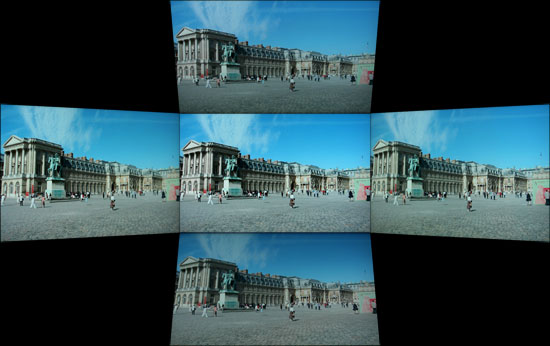 |
As this is an LCD designed for the professional market, it's no surprise that LaCie uses an S-PVA panel rather than a TN panel. Overall performance is similar to the Dell 2408WFP in terms of viewing angles, but unfortunately input lag is also just as bad (around 40ms).
The LaCie 324 includes two HDMI, one DVI, and one VGA input. It does have height adjustment and it will swivel about 170° to the left or right, but there is no pivot function. The height adjustment is also shorter than most other models, offering only 2.75" of vertical travel. The LaCie panel feels heavier and looks a bit bulkier than the competing offerings. That's not necessarily a bad thing if your primary concern is image quality, as it could be the added space is for something useful. All other things being equal, we would prefer a better stand that offers more vertical travel and a pivot function. At present, imaging professionals may have to choose function over form.
LaCie 324 Evaluation
At first blush, the LaCie 324 OSD seems more limited than the options on other LCDs. There are only three main screens, one of which is for PIP. The other two screens are full of useful adjustments, however. LaCie also uses touch-sensitive buttons, and we periodically encountered difficulty with activating the "down" button (i.e. we would press it, move our finger around, etc. all to no avail; exiting the menu and returning would usually correct the problem). We would have preferred tactile feedback, but the overall result wasn't quite as finicky as the Samsung buttons, in part because the six buttons have white labels that are clearly visible.
LaCie provides six color presets, five color temperature settings, and five gamma levels. The last should be of particular interest to those involved with desktop publishing, where the ability to switch between 1.8 and 2.2 gamma can be useful. The 324 also has an "Over Speed" option that is supposed to improve pixel response times. Again, we didn't notice any serious issues with pixel response, but unfortunately the "over speed" mode does not address input lag.
| LaCie 324 Resolution and Input Notes | |||
| DVI | HDMI | VGA | |
| 800x600 | Yes | Wrong AR; Stretches horizontally to fill LCD | Yes |
| 1024x768 | Yes | Wrong AR; Stretches horizontally to fill LCD | Yes |
| 1152x864 | Yes | Wrong AR; Stretches horizontally to fill LCD | - |
| 1176x664 | Poor scaling artifacts | Underscanned 720P | - |
| 1280x720 | Poor scaling artifacts | Yes | Yes |
| 1280x768 | - | - | Sets 1280x800 and clips top and bottom |
| 1280x800 | Wrong AR (1280x960) | Wrong AR; Stretches horizontally to fill LCD | Yes |
| 1280x960 | Yes | Wrong AR; Stretches horizontally to fill LCD | Yes |
| 1280x1024 | Yes | Wrong AR; Stretches horizontally to fill LCD | Yes |
| 1400x1050 | - | Wrong AR; Stretches horizontally to fill LCD | - |
| 1440x900 | Yes | Wrong AR; Stretches horizontally to fill LCD | Yes |
| 1600x1200 | Yes | Wrong AR; Stretches horizontally to fill LCD | Yes |
| 1680x1050 | Always has top/bottom black borders | Wrong AR; Stretches horizontally to fill LCD | Yes |
| 1768x992 | - | Underscanned 1080P | - |
| 1920x1080 | Interference/Static Present; Always has top/bottom black borders | Yes | Clips output to 1680x1050 |
| 1920x1200 | Yes | - | Yes |
There are four scaling options: Real, Smart Zoom, Zoom, and Dx2D. "Real" is the same as what other LCD manufacturers call "1:1". "Smart Zoom" stretches whatever resolution you are running to fill the LCD while maintaining the correct aspect ratio, and "Zoom" fills the entire LCD. We're not at all sure what the "Dx2D" is supposed to do; sometimes it looks the same as "Smart Zoom" and other times it looks like "Real", though in a few cases using it instead of one of the other scaling options will result in fewer scaling artifacts.
For the inputs, HDMI only works properly with 720P/1080P resolutions and should be avoided for most other resolutions if possible; otherwise you get a horizontally stretched image with black borders on the top and bottom. VGA connections work properly except for a couple resolutions, while DVI has scaling errors on several resolutions, including the frequently used 1680x1050. It also seemed as though the VGA input showed more signal interference than on other LCDs, but the cable we were using may have been to blame.
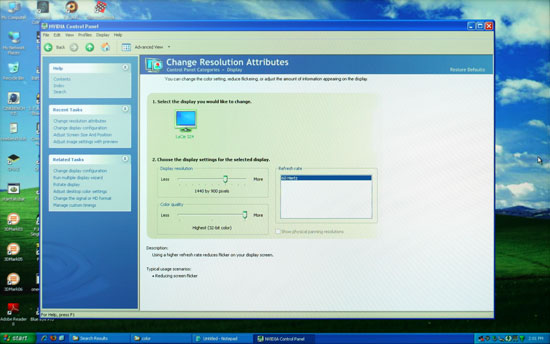 |
Scaling on the LaCie 324 looks good when it works properly, as seen here. Just do your best to avoid the problem resolutions/inputs listed in the chart above.
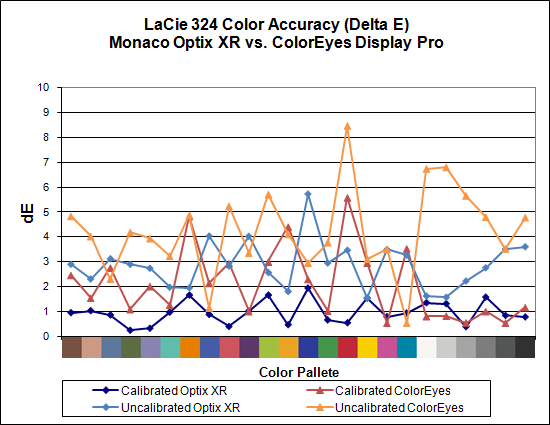
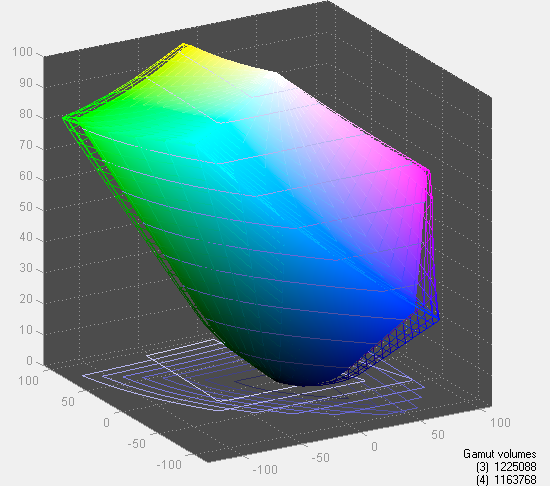
Considering this is a professional LCD, we were definitely interested in seeing what sort of color accuracy LaCie could achieve. If we had looked at the 324 before receiving some of the other monitors, the uncalibrated color accuracy would have been very impressive. As it stands, LaCie does well but professionals will still want to use calibration hardware and software. Color gamut is also good, coming in at 95%.
The question on our minds while reviewing the LaCie 324 is what exactly do users get for the extra ~50% price increase relative to the competition? We can say quite easily that we are not the target market, despite the fact that we do plenty of online publishing. For most users, 10-bit gamma correction and color lookup tables just aren't going to make that big of a difference. After all, Dell manages to achieve better color accuracy according to our measurements. However, the selection of gamma, temperature, and color options within the OSD will likely benefit certain users.
If you have a regular need to work at 1.6 gamma to 2.4 gamma, the LaCie may in fact be the better choice. The 10-bit gamma helps to provide better gradients without banding. Perhaps more important is the warranty that LaCie provides. A 3-year warranty isn't any better than what many of the other companies provide, but an advance replacement policy to minimize downtime is noteworthy. LaCie also sells a bundled package consisting of the 324 LCD with their blue eye pro software and colorimeter, and they state that the software is tuned for their hardware. Finally, LaCie is committed to using the same wide color gamut S-PVA panel on all 324 LCDs, so you won't find different versions with different panels. They test for color uniformity and only use panels that pass their testing, eliminating lower grade panels.
As a whole package, LaCie is clearly targeting professional users, from the LCD and warranty to their blue eye pro software and colorimeter. We did run some initial tests with blue eye pro, and one aspect that is definitely better than competing solutions is that the software and hardware worked under Vista 64-bit -- something we can't say of ColorEyes Display Pro or Optix XR Pro. There were some periodic pauses when we tried to use blue eye pro under 64-bit Vista, but it did successfully calibrate our test monitor.
Given the online price of $900 or more, we are more inclined to stick with one of the LCD alternatives. After all, $900 will get you pretty much any other 24" LCD plus appropriate calibration equipment -- sometimes with change left over. However, there's a reason LaCie is viewed as a professional solution and if that's your line of work, the extra cost should be easy to stomach as a long-term investment.
Samsung 2493HM Specifications and Appearance
| Samsung 2493HM Specifications | |
| Video Inputs | DVI with HDCP support HDMI Analog (VGA) |
| Panel Type | TN (SAM 0369) - possibly LTM240C T03 |
| Pixel Pitch | 0.270mm |
| Colors | 16.7 million (6-bit with
dithering/interpolation?) 82% color gamut |
| Brightness | 400 cd/m2 |
| Contrast Ratio | 1000:1 Static Up to 10000:1 Dynamic |
| Response Time | 5ms GTG |
| Viewable Size | 24" diagonal |
| Resolution | 1920x1200 |
| Viewing Angle | 160 horizontal/vertical |
| Power Consumption | <100W max stated 69W max, 18W min measured |
| Power Savings | <2W |
| Screen Treatment | Matte (non-glossy) |
| Height-Adjustable | Yes - 3.94 inches |
| Tilt | Yes - 25 degrees back/5 degrees forward |
| Pivot | Yes |
| Swivel | Yes - 170 degrees left/right |
| VESA Wall Mounting | 200mm x 100mm |
| Dimensions w/ Base (WxHxD) | 22.24" x 17.62" x 9.84" lowered
(WxHxD) 22.24" x 21.55" x 9.84" raised (WxHxD) |
| Weight w/ Stand | 18.74 lbs. |
| Additional Features | (2) USB 2.0 - right side of stand (USB connection to PC required) |
| Audio | 2 x 2W Speakers Audio in, Line out |
| Limited Warranty | 3 year parts and labor |
| Price | Online starting at ~$450 |
Last (at least alphabetically) among the monitors we're testing today is the Samsung 2493HM. We recently looked at the Samsung 245T, which is from Samsung's professional line of monitors. The 2493HM is intended more as a consumer device, so there are a few cost-cutting measures in place.
In terms of features, the 2493HM is similar to what we've seen already. Like the MK241H, you get DVI, HDMI, and VGA connections along with built-in speakers. Unlike the ASUS, it provides a base stand that allows height, pivot, tilt, and swivel functionality. It also includes two USB ports on the base stand, but since you use one USB port from your computer to power these, the net gain is only one port.
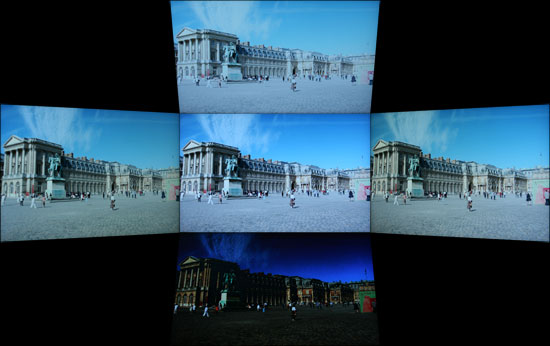 |
The 2493HM uses a TN panel, which again means limited viewing angles. However, the viewing angles do seem to be a little better than on the other two TN displays we reviewed today. Response times and input lag -- or the lack of input lag -- are also similar to the other two TN displays.
Samsung uses a glossy finish on most of the 2493HM surfaces, but the LCD panel has a matte finish. With all the other reflective, fingerprint- grabbing surfaces that seems a little odd, but then most of us still prefer non-glossy LCDs. The back of the stand is also a bit more bulky than what we see on the Gateway and Dell offerings, but since the stand is mostly plastic, this is one of the lighter LCDs. (The Gateway FHD2400 is actually lighter, however.)
Samsung 2493HM Evaluation
The OSD options in general are similar to what we found on the Samsung 245T, though there are some differences. For example, picture-in-picture mode is missing and the options for color control are slightly more limited. Both of these changes are in tune with the "consumer" target audience. One change that we definitely don't like is the button style for the OSD. Put bluntly, we find the OSD buttons to be extremely annoying. There is no tactile feedback, and it can be difficult to see the labels against the shiny LCD bezel. Gateway gets around this by using blue LEDs to show you where the buttons are, but on the 2493HM we always felt like we were searching to find a proper place to "press". There were many occasions where we mistakenly pressed the wrong button. On the plus side, you don't have any buttons clearly visible on the front of your display, and once you have the display set up and configured properly you probably won't need to enter the OSD menus too frequently.
Samsung provides a couple "magic" options in their OSD. MagicBright is simply their name for the preset color/brightness/contrast settings, and there are seven options. Like all the other displays we've tested so far that feature dynamic contrast, we found the net result less than perfect -- color accuracy in particular is horrible when dynamic contrast is enabled (i.e. Delta E of over 12.0 after calibration). We stuck with the "custom" color setting for the remainder of our testing. You also get MagicColor, which again seems to enhance color rendering in contrast at the cost of color accuracy. Color Tone provides for other settings (cool, normal, warm, and custom) and then there's Color Effect where you can have the LCD render in grayscale or sepia tones. (Why you would want that is not something that is immediately clear.) There are also three gamma settings; mode 1 appears to correspond to 2.2 gamma, with modes 2 and 3 providing higher gamma levels.
There
are only two choices for aspect ratio control (listed under Image Size): Normal
and Wide. There is also an "AV mode" setting that enables or disables
overscan on certain resolutions. Again, why anyone would actually want to
enable overscan is beyond us. "Wide" usually stretches your selected
resolution to fill the entire screen, while "Normal" squishes things
into a standard 4:3 aspect ratio. Note that there is no 1:1 setting, so we say "yes"
in the chart below for situations where the chosen resolution fills the screen
properly without any work on the part of the user. Also note that in these cases,
the Image Size functionality is disabled. This means that the 2493HM will always have the wrong aspect ratio on 16:9 resolutions.
| Samsung 2493HM Resolution and Input Notes | |||
| DVI | HDMI | VGA | |
| 800x600 | Set to "Normal" | Set to "Normal" | Set to "Normal" |
| 1024x768 | Set to "Normal" | Set to "Normal" | Set to "Normal" |
| 1152x864 | Set to "Normal" | Set to "Normal" | Set to "Normal" |
| 1176x664 | AV Mode = Overscan to fill LCD more | AV Mode = Overscan to fill LCD more | - |
| 1280x720 | Yes | Yes | Yes |
| 1280x768 | Set to "Wide" | Set to "Wide" | Set to "Wide" |
| 1280x800 | Yes | Yes | Yes |
| 1280x960 | Set to "Normal" | Set to "Normal" | Set to "Normal" |
| 1280x1024 | Set to "Normal" | Set to "Normal" | Set to "Normal" |
| 1400x1050 | Always stretches to fill LCD | Always stretches to fill LCD | - |
| 1440x900 | Yes | Yes | Yes |
| 1600x1200 | Set to "Normal" | Set to "Normal" | Set to "Normal" |
| 1680x1050 | Yes | Yes | Yes |
| 1768x992 | AV Mode = Overscan to fill LCD more | AV Mode = Overscan to fill LCD more | - |
| 1920x1080 | Yes | Yes | Yes |
| 1920x1200 | Yes | Yes | Yes |
Again, the scaling settings are limited as there is no 1:1 or proportional mode. Frequently the 2493HM scales incorrectly without manual selection of the correct scaling algorithm ("Normal" for 4:3 and 5:4 and "Wide" for 16:9 and 16:10). This is a concern with all three input types, though it's noteworthy that HDMI and DVI perform identically during testing. You can set up the "Custom Key" option in the OSD so that it will switch between the two scaling modes (or alternately use the custom key to cycle between the MagicBright, MagicColor, or Color Effect options). We couldn't enable the NVIDIA Scaling options on NVIDIA GPUs for whatever reason - the control panel always reverts to LCD control. (That occurs on some other LCDs, but they usually have better scaling functionality.) The "AV Mode" option seems odd - why would you want overscan? You can use it with 1176x664 and 1768x992, but it's better to use 720P and 1080P in the first place. You will need to disable it on many of the WS resolutions. On the plus side, the VGA auto centering/adjustment is relatively quick and accurate and remembers the settings after the initial setup.
 |
Image scaling did perform well at non-native resolutions, though we would have preferred the presence of 1:1 and aspect scaling as opposed to only getting "Normal" and "Wide". Now let's look at the color accuracy and gamut. Again, note that we disabled MagicColor and used the Custom setting on MagicBright and Color Tone.


Color gamut is the lowest of any of the tested LCDs today, coming in at 75% of Adobe RGB 1998. As a consumer display, however, this shouldn't be a major problem - sRGB has a much smaller color space, and the 2493HM gamut is fine for normal use. There are two sides to the color accuracy story. On the one hand, calibrated color is pretty mediocre, with an average Delta E of 1.8 and several colors in the 3.0 and above range. The uncalibrated colors on the other hand score almost the same as the calibrated colors, with an average Delta E of 2.4. That puts the 2493HM in second place among tested LCDs for uncalibrated color accuracy.
To Samsung 2493HM more or less lives up to its billing as a consumer LCD. It doesn't have all the high-end features that we find on displays like this Dell 2408WFP, but the default color accuracy is quite impressive and you also avoid the input lag that we measured on all the S-PVA panels. Online prices start at only $450, including a 3-year manufacturer warranty. Outside of demanding image professionals, we think the 2493HM is a great choice for a display that provides accurate colors at an extremely attractive price. Depending on whether you prefer glossy or matte finishes on your LCD panel, it's really a tossup between the Gateway FHD2400 and the 2493HM.
Input Lag and Response Times
We've heard frequent complaints about input lag on various LCDs, particularly after our last review of the Samsung 245T. We decided it was time to take a closer look at the subject and see if we could come up with a repeatable test. We ended up settling on a test similar to what we were using to show response times, with a few changes.
We run the Wings of Fury benchmark in 3DMark03, with the resolution set to the native LCDs resolution -- in this case 1920x1200. Our test system is an overclocked quad-core Q6600 (3.30 GHz) running two Radeon HD 3870 cards in CrossFire on a Gigabyte GA-X38-DQ6 motherboard. (This is the same system used in our initial testing of 3DMark vantage.) We connect the test LCD and a reference LCD to two outputs from the Radeon 3870 and set the monitors to run in clone mode.
The reference Monitor is an HP LP3065, which we have found to be one of the best LCDs we currently possess in terms of not having input lag. (The lack of a built-in scaler probably has something to do with this.) [Ed: Before you ask, no, I do not have any CRTs around that I can use as a reference monitor, and frankly I don't want any. They're huge, heavy, and require more power, and the best ones were made over five years ago. Sorry - LCDs are where everything is heading. R.I.P. CRT.]
While the benchmark is looping, we snap a bunch of pictures of the two LCDs sitting side-by-side. We set our camera to f/2.2, ISO-400, and a 1/400 sec exposure in order to get a clear snapshot of the on screen action. (Note that these settings have changed from previous articles.) 3DMark03 lists a runtime with a resolution of 10 ms at the bottom of the display, and we can use this to estimate whether a particular LCD has more or less input lag in our reference LCD. We then sort through the images and discard any where the times shown on the LCDs are not clearly legible, until we are left with 10 images for each test LCD. We record the difference in time relative to the HP LP3065 and average the 10 results to come up with an estimated input lag value.
It's important to note that this is merely an estimate -- whatever the reference Monitor happens to be, there are some inherent limitations. For one, LCDs only refresh their display 60 times per second, so any measurement less than approximately 17 ms is not 100% accurate. Second, the two LCDs can have mismatched vertical synchronization, so it's entirely possible to end up with a one frame difference on the time readout purely because of this. That's why we average the results of 10 images, and we are confident that our test procedure can at least show when there is a consistent input lag/internal processing delay.
Here is a summary of our results, followed by a sample image chosen to highlight the pixel response time of the LCDs. Despite what the manufacturers might advertise as their average response time, we found most of the LCDs were equal in this area -- they all show roughly a one frame "lag", which equates to a response time of around 16 ms.
| Display Input/Processing Lag vs. HP LP3065 | |||||||||||
| One | Two | Three | Four | Five | Six | Seven | Eight | Nine | Ten | Average (ms) | |
| ASUS MK241H | 10 | 0 | 0 | 0 | 0 | 0 | 0 | 0 | 0 | 0 | 1 |
| Dell 2407WFP | 10 | 20 | 30 | 20 | 10 | 10 | 30 | 30 | 10 | 20 | 19 |
| Dell 2408WFP | 30 | 40 | 40 | 40 | 30 | 30 | 40 | 30 | 50 | 50 | 38 |
| Gateway FHD2400 | -10 | -10 | 0 | 10 | 10 | 10 | 0 | 10 | 10 | 0 | 3 |
| Gateway FPD2485W | 30 | 10 | 20 | 20 | 20 | 10 | 0 | 30 | 20 | 20 | 18 |
| HP w2408 | 10 | 10 | 0 | 0 | 0 | 0 | 0 | 10 | 0 | 0 | 3 |
| LaCie 324 | 40 | 30 | 40 | 30 | 40 | 50 | 40 | 50 | 50 | 30 | 40 |
| Samsung 245T | 30 | 30 | 30 | 30 | 30 | 20 | 30 | 30 | 20 | 20 | 27 |
| Samsung 2493HM | 0 | 10 | 0 | 0 | 0 | 10 | 0 | -10 | 0 | 10 | 2 |
 ASUS MK241H |
 Dell 2407WFP |
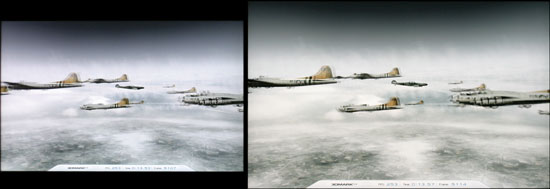 Dell 2408WFP |
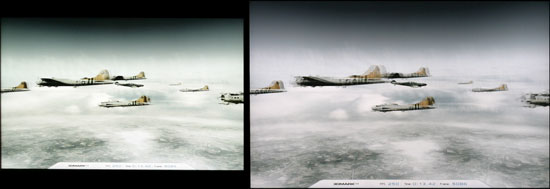 Gateway FHD2400 |
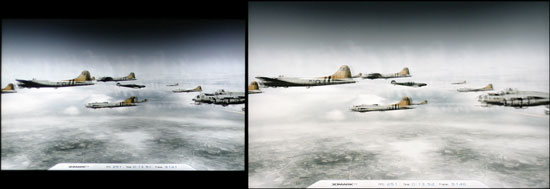 Gateway FPD2485W |
 HP w2408 |
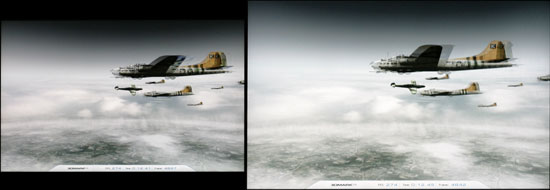 LaCie 324 |
 Samsung 245T |
 Samsung 2493HM |
The table tells a clear story: all of the S-PVA panels as we mentioned clearly have more input lag/internal processing lag than all of the TN panels. This is a pretty shocking result, as it indicates that the problem may actually be inherent in S-PVA technology, although there are still panels that do better in this area. The Gateway FPD2485W and Dell 2407WFP both have an input lag just under 20 ms -- or a one frame delay on average. The Samsung 245T has a 27 ms delay on average, indicating it would be one or two frames behind what is actually happening. Worst of all are the Dell 2408WFP in the LaCie 324, which have a two or three frame lag. (This is discounting any other lag that is present between the user and what they are seeing on the display; there's also a slight amount of lag associated with reading input from your mouse/keyboard, processing that input, rendering the resulting image, and sending that to your display.) In contrast, the four 24" TN panel LCDs all more or less match the HP LP3065.
Thus, we have no choice but to conclude that if you are seriously concerned about input lag, you will have to sacrifice viewing angles, color accuracy, and/or overall display quality in order to avoid this on the current 24" offerings. On the other hand, we have played games on all of the test LCDs, and we honestly can't say that we noticed any difference in our overall performance. But we weren't hopped up on Bawls and we don't have a 1337 name like Fatal1ty. Competitive gamers will probably feel differently.
Brightness and Contrast Ratio
For the brightness (luminance), contrast, and color accuracy tests, we depend on a hardware colorimeter and software to help calibrate the displays. We use a Monaco Optix XR (DTP-94) colorimeter and Monaco Optix XR Pro software, and we also test with ColorEyes Display Pro. Results in nearly every case have been better with Monaco Optix XR Pro, so we only report the ColorEyes Display Pro results on the monitor evaluation pages. We'll start with a look at the range of brightness and contrast at the default LCD settings while changing just the brightness level. (In some cases, it will be necessary to reduce the color levels if you want to achieve a more reasonable brightness setting of 100 or 120 nits.)
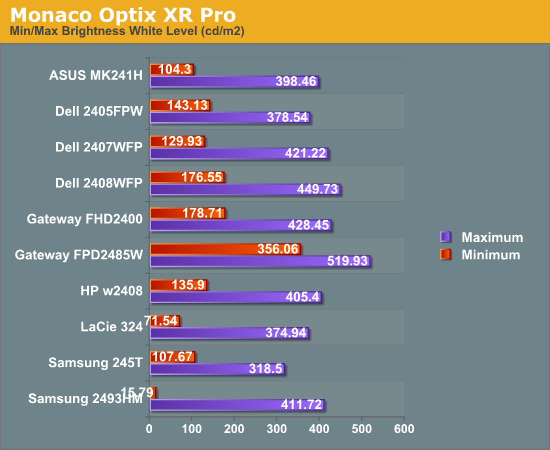
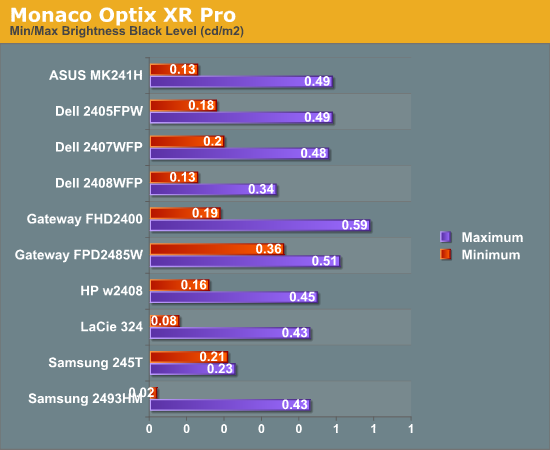
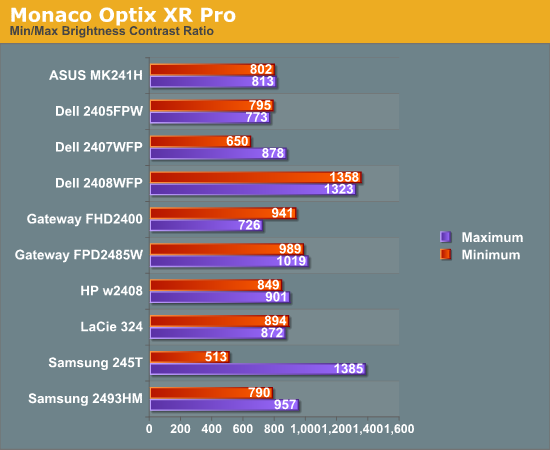
Nearly all of the LCDs have a maximum brightness level of around 400 nits, which is more than sufficient and is actually brighter than what most users prefer to use in an office environment. Minimum brightness without adjusting other settings is often above 100 nits, so it will be necessary to go in and adjust color levels as mentioned already. The Gateway FPD2485W is the prime example of this, where the default settings have a minimum brightness of 356 nits. Black levels are also reasonably consistent among the LCDs, with maximum and minimum black levels corresponding to the maximum and minimum white levels.
More important than the luminosity is the contrast ratio that is achievable at the various brightness settings. Here we begin to see some differences, with many of the LCDs following in the 800:1 ~ 900:1 range. The Dell 2408WFP and Samsung 245T stand out as having some of the highest contrast ratios, with the Dell taking the lead as it maintains the high contrast ratio even at low brightness settings. However, we should also mention that in practice the difference between 500:1 and 750:1 really isn't very significant for most users. It's only when you fall below 500:1 that colors really start to look washed out.
Color Gamut
We've already discussed color gamut of individual LCD evaluations, but it's a new addition to our LCD testing. This is something we wanted to add previously, but we lacked a good utility for generating the appropriate charts and data. We recently found out about Gamutvision, a utility developed by Imatest LLC. They were kind enough to provide us with a copy of their software, and it does exactly what we need. We compared the color profiles of all previously tested LCDs to the Adobe RGB 1998 color profile. Graphs of the individual gamut volumes are available on the evaluation pages. Below is a chart showing the percentage of the Adobe RGB 1998 gamut from the various displays.
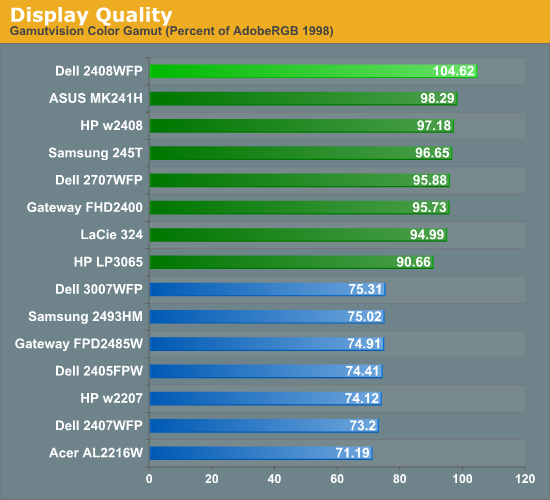
We basically end up with two tiers of quality in terms of color gamut. Filling the bottom tier are mostly older displays that have 82% NTSC color gamut backlighting. These may seem drastically inferior to the newer LCDs, but keep in mind that if you are just using the standard sRGB profile these LCDs look fine. It's only when you work in applications like Adobe Photoshop with its improved color space that you begin to notice a difference between the displays. Most of the newer displays now have ~95% Adobe RGB color gamuts, and the Dell 2408WFP actually surpasses the Adobe RGB 1998 color space. The only display in this round up that doesn't make it into the upper tier is the Samsung 2493HM.
Power Requirements
Another new test we decided to add with this roundup is a quick look at power requirements. Like the above tests, power requirements are checked at default LCD settings while varying the brightness setting. Also note that minimum power requirements are going to depend largely on how dim the backlight is at the minimum setting, so looking at the above charts it shouldn't be difficult to figure out that the Samsung 2493HM will require less power than the others when it's only putting out 16 lumens.
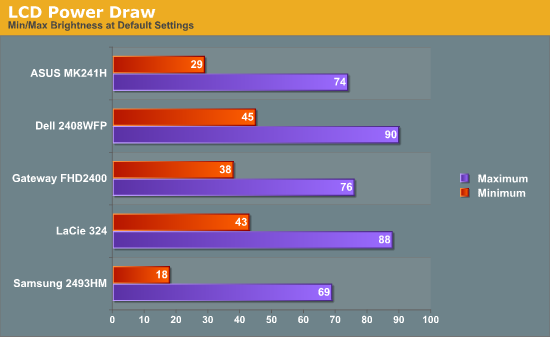
We've only begun collecting this data with this batch of LCDs, so we don't have any clear patterns established yet. However, it's interesting to note that the two S-PVA panels to seem to draw slightly more power than the three TN panels. At equivalent brightness settings, the differences in power draw are very small.
Color Accuracy
Imaging professionals definitely like to have accurate colors, and the best way of assuring that your display shows the proper colors is to use a colorimeter and calibration software. However, not everyone has access to such tools and many users are unwilling to spend over $200, so we test before and after calibration. (Put more accurately, we calibrate the monitors and then tweak the created profile back to an uncalibrated state so that we can evaluate the performance of the display in its default state.) For calibration, we target a white level of 250 nits -- anything more than that is too bright in our opinion. We also do a second calibration targeting a white level of 100 nits, which would be useful when working on material that will end up in print form. Before we get the results, here are the display settings we used on the test LCDs. We let the LCDs stabilized for at least one hour before performing measurements.
| LCD Brightness and Contrast Settings | ||
| Standard Calibrated (~250 nits) | Calibrated for Print (~100 nits) | |
| ASUS MK241H | 45 Brightness, 80 Contrast 100-100-100 RGB |
50 Brightness, 80 Contrast 54-51-73 RGB |
| Dell 2408WFP | 50 Brightness, 50 Contrast 80-80-80 RGB |
48 Brightness, 50 Contrast 55-55-55 RGB |
| Gateway FHD2400 | 70 Brightness, 70 Contrast 76-77-92 RGB |
50 Brightness, 50 Contrast 57-57-70 RGB |
| LaCie 324 | 35 Brightness, 0 Contrast 128-128-128 RGB 2.2 Gamma, 6500K |
7 Brightness, 0 Contrast 128-128-128 RGB 2.2 Gamma, 6500K |
| Samsung 2493HM | 60 Brightness, 75 Contrast 100-100-100 RGB |
28 Brightness, 75 Contrast 46-37-65 RGB |


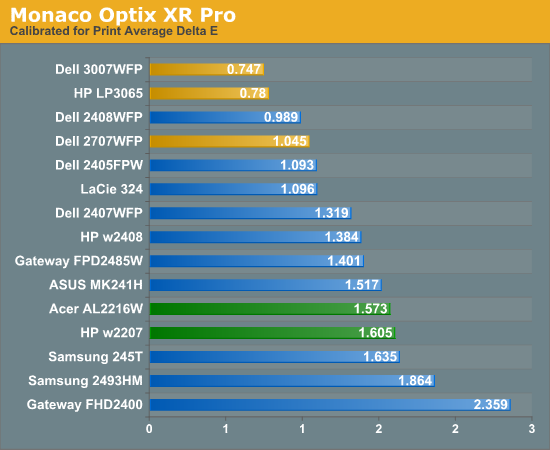
Starting with the uncalibrated results, it's pretty easy to see why we feel calibration tools are necessary for most users. This is not to say that you can't be happy with inaccurate colors -- your eyes will compensate, and some people prefer warmer (redder) or cooler (bluer) tones. However, if you're doing work with images or video as an example, it is important that what you see on your display matches as much as possible what others will see on their displays. Of the tested LCDs, only four are able to achieve an average Delta E of less than 3.0 without calibration -- three of which happen are part of this roundup. That's encouraging, as it indicates LCD manufacturers may be spending a bit of extra time to ensure that at least one of the settings will provide neutral, accurate colors. The real shocker however is the Dell 2408WFP. Its uncalibrated Delta E reaches an exceptional 1.7 -- a score that's better than several of the LCDs after calibration!
With calibration, all the scores improve substantially, but anyone serious about color accuracy is probably going to want an average Delta E of around 1.0 or less after calibration. Of the tested monitors, the 24" Dell displays (all three models that we've tested), the LaCie 324, and the two 30" LCDs all manage to accomplish this, along with the Dell 2707WFP and Samsung 245T. Switching to appropriate "printing" settings puts the three largest LCDs at the top of the charts, along with the Dell 2408WFP (and the old 2405FPW) and LaCie 324.
Most of the LCDs in this roundup place in the middle or upper portion of the above graphs, with one exception. The Gateway FHD2400 comes in last or in second to last in all three tests. We actually really like the Gateway display for many of its features, but in terms of color accuracy it is definitely lacking. We spent a substantial amount of time trying to tweak the settings in order to achieve better results, all to no avail. There's more to LCDs than color accuracy, of course, and the price and appearance might be enough to help you overlook the relatively poor performance here.
Conclusion and Awards
Three years ago, I purchased my first 24" LCD, the Dell 2405FPW. It was on sale, so I got it at an absolute steal: only $1000! (Regular price was $1350 at the time.) Three years later, you can now find even better LCDs for roughly half that price. That's one of the great benefits of LCD technology over CRTs: prices may have started out higher, but they are dropping rapidly into much more affordable ranges. 21/22" CRTs seemed to bottom out at around $500 for years before they finally started to disappear altogether. There are still users that prefer the CRT experience, but after my upgrade three years ago I have never looked back.
Our roundup today examined five recent LCD introductions from different companies. Combine that with the 24" LCDs we've reviewed previously and we now have a good basis for ranking the current LCDs. If you're looking for a one-size-fits-all solution, unfortunately we cannot come up with a single recommendation. The 24" LCD market has split into two segments. On the one hand, we have S-PVA panels that provide great colors and viewing angles but struggle with input lag, and on the other hand we have TN panels that may not offer the most accurate colors but they have no discernible input lag (at least when compared to other LCDs). We are not bothered by input lag, but competitive gamers depend on every potential advantage they can get, so 20 or 40 ms can and will make a difference. We will therefore select what we feel is the best LCD for each of these markets.
 |
 |
This is not to say that other LCD options are not worth considering. All of the 24" LCDs we've reviewed so far are at worst decent quality, and several can easily compete with our Editors' Choice recipients. The LaCie 324 for example is a professional monitor at a professional price; it's not something we would recommend for casual users, but imaging professionals and users in the desktop publishing industry might be swayed by its feature set. Depending on pricing, some of the other LCDs might become more or less interesting.
Unfortunately, we're still missing our "one ring to rule them all". [Ed: …and in the dorkness bind them?] What we'd really like to see is a single LCD that can combine the best aspects of the Dell 2408WFP with low input lag, and it might be interesting to see a glossy S-PVA panel as an option from one of the manufacturers. A lot of us still prefer matte finishes, but at least one of the editors has been swayed to the dark side by the Gateway FHD2400. If there is an inherent trait of S-PVA panels that causes input lag, another alternative we would be very interested in seeing is a 24" S-IPS panel. Considering our 30" HP LP3065 uses an S-IPS panel and matches the TN panels in input lag, that could be the perfect solution. We're sure there are plenty of users out there that would even pay extra money for such an LCD.



































































